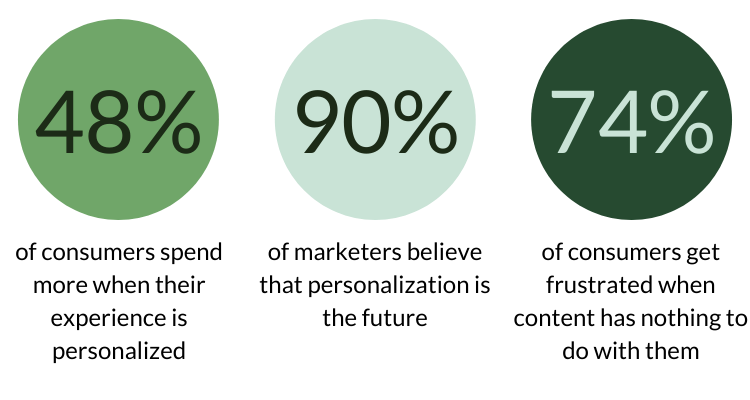Boost eCommerce Sales with Personalization and Automation
Consumers spent billions on Direct-to-Consumer (DTC) wine shipments in 2019, and according to the Silicon Valley Bank Report, DTC sales make up over 60 percent of the average family winery’s revenue. You can bet that 2020 will show an even larger chunk of revenue being made through DTC channels. eCommerce personalization and automation has never been more important.
The wineries and other craft producers with the largest portion of online sales know a thing or two about eCommerce personalization and automation. If you’re not familiar with these two powerful marketing tools, you should be. It’s no longer enough to simply make your wine or beer available online. In order to attract and retain customers, you’ve got to make every shopper feel like you know them.
Thankfully, with a few simple tweaks to your eCommerce site, you can serve up an online shopping experience practically tailor-made to your customer’s needs—and streamline your winery’s or brewery’s marketing efforts in the process.
Before we dive into how these tools can help you increase profits, let’s cover the basics.
PERSONALIZATION
The practice of creating personal interactions and experiences on your eCommerce site through individualized offers, product recommendations, and other content based on your website visitors’ previous actions, demographics, and other personal data.
AUTOMATION
The combination of software and processes that help eCommerce businesses simplify workflows and eliminate repetitive tasks to deliver personalization.
In short, personalization ensures your messages are relevant to your customers, while automation helps you deliver the right content to the right audience at the right time. Your eCommerce site needs both in order to deliver an outstanding customer experience.
The Benefits of Personalization
These days, customers expect personalization when they shop online. Smart Insights, a publisher and learning platform for digital marketers, revealed some statistics that prove this point.
Now that you know how much your customers will appreciate personalization on your website—and how much more they’ll be likely to spend—you need to understand your customers so you can deliver a more personalized experience.
Buyer personas—fictional representations of your ideal customers—help you uncover the information you need to market to more precise segments of your target market. To create buyer personas, collect data from your customer database, website analytics, social media pages, customer surveys, and market research.
GOOD BUYER PERSONAS SHOULD INCLUDE:
Demographics: Gender, Age, Geographic Location, Occupation, Income, Education Level
Hobbies and Interests (Besides wine and beer!): Golf, Travel, Reading
Shopping Motivations: Convenience, Brand Loyalty, Local Products
Frustrations/Concerns: Poor Customer Service, Hard to Navigate Websites
Preferred Communication Method(s): Email, Social Media, Text Message or Direct Mail
Preferred Shopping Channel(s): In-Person, Online, Events
Websites/Online Channels Visited Frequently: Facebook, Amazon,
With this information in hand, you’re ready to automate your marketing efforts so you can reach out to customers and prospects more frequently with the information that’s relevant to them.
The Beauty of Automation Technology
Marketing automation helps you stay connected with your target audience—and find more people just like them so you can grow your sales online. Once you’ve flagged a customer in your software, you can set and (almost) forget your marketing campaigns to target people based on their behavior, preferences and previous sales.
HERE ARE SOME EXAMPLES OF AUTOMATED EMAILS YOU CAN SCHEDULE TO BE SENT:
Welcome new wine club subscribers to the program
Reach out to people who abandon online shopping carts
Win back lapsed customers with special offers
Share blog updates from your RSS feed
Remind wine club members to resubscribe
Send birthday messages to customers
As you can see, automation helps eliminate repetitive marketing tasks, freeing up your staff to focus on other aspects of running your winery or brewery.
What You Need for Automation
To automate emails like the ones mentioned above, you’ll need Customer Relationship Management (CRM) software from a vendor such as HubSpot, Salesforce, or MailChimp. These programs automatically track the interactions you have with your customers and potential customers.
To take full advantage of your CRM’s capabilities, you’ll also need to connect your eCommerce, social media, and other online systems through Automatic Programming Interfaces (APIs) and webhooks. These allow your systems to automatically “talk to each other” and retrieve the information they need to automate tasks.
APIs, for example, can automatically grab twitter mentions of your business and post them on your blog. And webhooks can automatically credit a customer’s account with a discount promotion once they’ve purchased a certain number of bottles.
As the technology we’ve outlined in this post continues to transform how people shop, wineries that use personalization—and its time-saving partner automation—will come out ahead. Creating a customized customer experience will not only increase retention and drives new sales, but it will also ensure your winery has an infrastructure in place to simplify managing the future growth of your business.
We’re always looking for ways to help our customers use the latest technology and digital marketing tools to grow their DTC business. To make sure you don’t miss a thing, subscribe to our blog.











